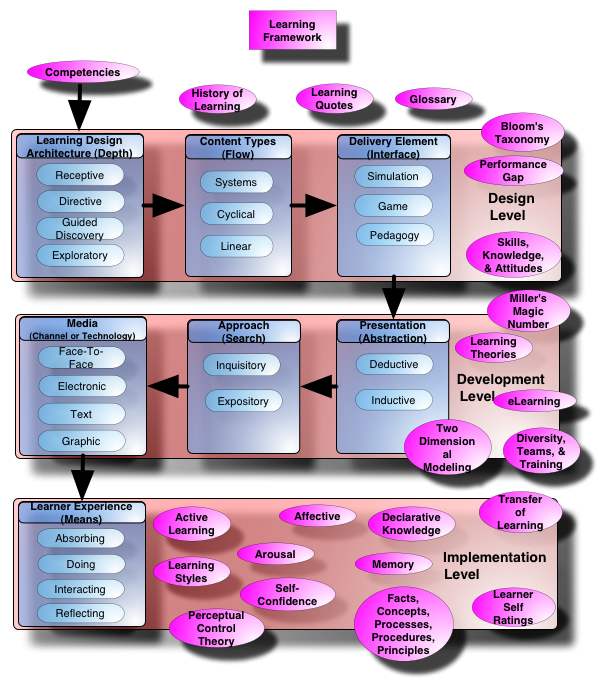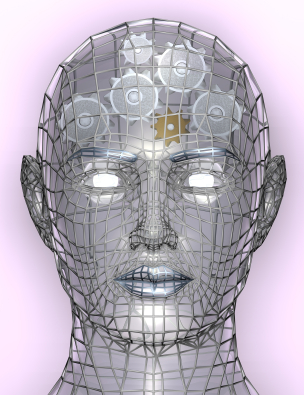Note: This site is moving to KnowledgeJump.com. Please reset your bookmark.
Cognition, Knowledge Systems and Learning
After the presenting task (task at hand) passes through the metacognitive system, it is passed on to the cognitive system that processes information that is essential for learning the task (Anderson, 1995). This process includes the effective execution of steps for problem solving and creates novel ideals for the construction of new concepts. It also (Marzano, 1998):
-
Stores and retrieves knowledge into permanent memory.
-
Processes knowledge by manipulating so that it can be used for specific tasks.
-
Inputs and outputs information by communicating with others.
-
Uses knowledge to accomplish specific tasks.
It accomplishes these processes by drawing upon the knowledge domain that consists of information, mental processes, and psychomotor processes.
Information
Information can be thought of as the library within us that organizes how we store information. All information can be broken down as elements, as shown in the chart below.
Elements In The Information Domain Hierarchy
(listed from the lowest to the highest)
Vocabulary Terms — The meaning of a word at a very general level. Facts — Information about specific persons, places, events, etc. These are very specific, such as the United States has fifty states. Time Sequences — First one thing happened, then another thing happened. These are important events between two periods in time. For example, Columbus discovered America in 1492 and America declared itself a free nation in 1776. Cause/Effect Sequences (If/Then) — One event effects another. It can be simple, such as a blown-out tire caused the accident or complex as there were a number of events that led to the Civil War. Episodes — Events that have a setting, participates, duration, and effects (e.g. Word War II). Generalizations — Statements in which examples can be provided (e.g. love is one of the most powerful human emotions). Principles — Generalizations that deal with relationships (e.g. the increase in lung cancer is directly proportional to the increase in smokers) . Concepts — A general category which a number of principles, generalizations, time sequences, cause/effect sequences, episodes, and vocabulary terms fall (e.g. learning, democracy). |
Notice that in the information domain, each element builds upon the other. For example, you must understand the vocabulary terms before you can understand a fact. At the top of the domain are Concepts, which are the most difficult elements for a learner to extrapolate.
Mental Processes
The Mental Process domain are methods for accomplishing a task, such as the steps for picking up a load with a forklift or the steps for solving an algebra problem.
Mental Process Hierarchy
(listed from the lowest to the highest)
|
Single Rule — Does not have a list of steps. It consists of one IF/THEN statement. e.g., if it is the beginning of a new sentence, then capitalize the first letter. Algorithms — Has very specific steps which leads to specific outcomes. e.g., performing a math calculation Tactics — Normally, these do not consists of a set of steps that must be performed in specific order. e.g., reading a histogram (it has rules for reading, but it does not have to be done in order). Macro Process — A process that has a diversity of possible outcomes and involves the execution of many interrelated subprocesses. e.g., writing a term paper, using laboratory equipment. |
Psychomotor Process
The psychomotor domain are our physical skills and abilities.
|
See the section on Psychomotor in Bloom's Taxonomy |
Next Steps
Next chapter: Other Supporting Learning Theories
Return to the introduction: Self, Metacognition, Cognition, Knowledge Systems
References
Anderson, J. R. (1995). Learning and Memory: An integrated approach. New York: John Wiley & Sons.
Marzano, Robert J. (1998). A Theory-Based Meta-Analysis of Research on Instruction. Mid-continent Aurora, Colorado: Regional Educational Laboratory. Retrieved from http://eric.ed.gov/?id=ED427087


